Put the petal to the metal and take to the road for Texas’ annual wildflower show
In Full Bloom
For many, wildflower season begins with the first burst of spring bluebonnets.
But windflowers can pop and flutter in January breezes if conditions are right. And golden groundsel? It often emerges in early March, when Texans are still deciding whether or not to put away their winter coats. For those yearning for vibrant fields of firewheels that transform roadsides and usher in sunnier days, the best time to explore is generally mid-March into the beginning of summer, depending on the year’s temperature and rainfall. There’s also a fall deluge of blooms when asters, purple passionflower, and yellow goldenrod make their debut.
That’s all to say, the growing season is a near-yearlong phenomenon—if you know where to look. To help you make the most of the profusion of wildflowers covering the state’s landscapes, we’ve put together a curated guide to the best botanical festivals, breathtaking drives, and photo-op spots that’ll knock your stalks off.
Go With the Flower
During that halcyon time after the frosts of winter and before the sweltering temps of summer, there are plenty of reasons to get outside. Wildflower festivals crop up in March and April across the state, offering the perfect excuse to take a trip to celebrate Texas nature at its finest.
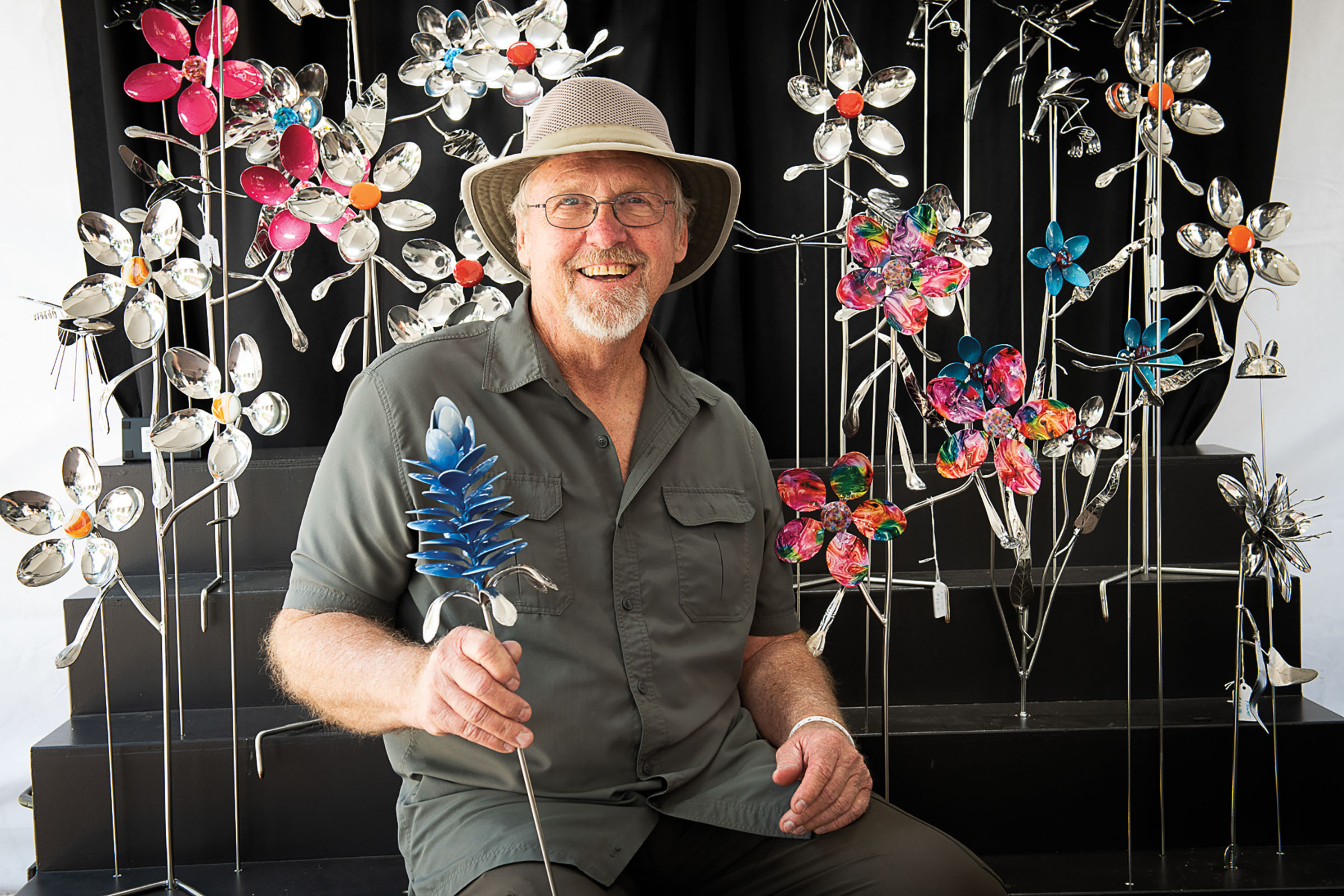
The Ennis Bluebonnet Festival. Photo by Theresa DiMenno
wildflowertrailsoftexas.org
Burnet carries the official distinction of the “Bluebonnet Capital of Texas,” so it only makes sense that the town holds an annual Hill Country Bluebonnet Festival. During the weekend of April 12-14, there’s a biergarten, a domino tournament, live music, and a fun run. There are also several wineries in the area, such as 7 Creeks Vineyard, where festivalgoers can unwind with a flight of local sips. Event is free; Saturday night concert is $20.
101 N. Pierce St., Burnet.
bluebonnetfestival.org
The small city of Ennis, just southeast of Waxahachie, hosts the Ennis Bluebonnet Trails and Festival each April, with over 40 miles of mapped driving trails to traverse. The festival is held in the historic downtown, with music, shopping, and kid-friendly activities. The Ennis Garden Club also offers guided tours for larger groups, so be sure to reserve one in advance. $5 for adults; kids under 12 are free.
201 NW. Main, Ennis.
bluebonnettrail.org
Drive and Seek
The beloved bluebonnets that blanket many roadsides and hills may be the most famous of Texas’ blooms, but different corners of the state offer more singular sights. These six drives meander through some of the most unique collections of flora in the Lone Star State, while also providing delectable detours for those hungry for historic barbecue, crisp brews, and the best pizza ever dished out of a converted horse trailer. —Melissa Gaskill
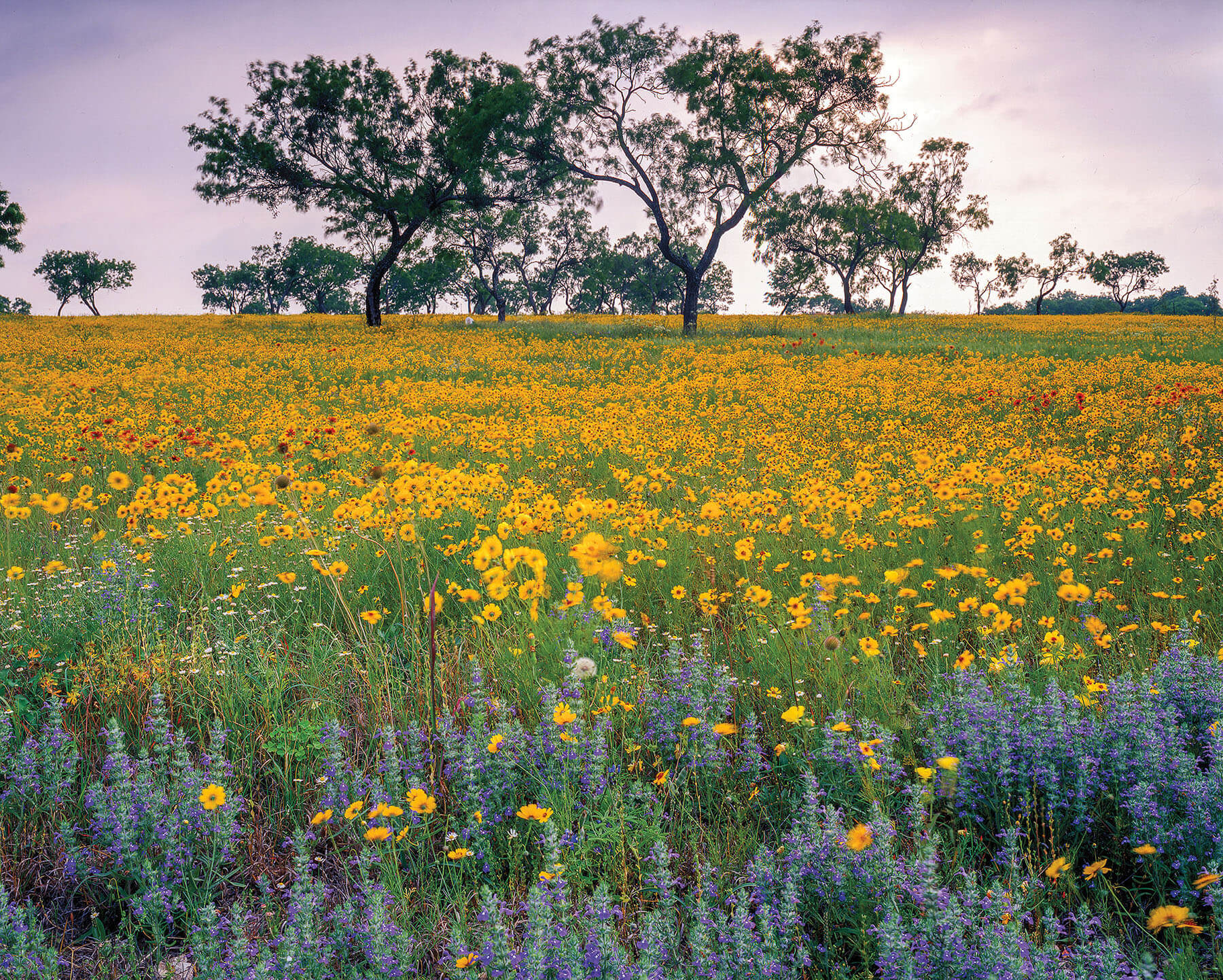
Indian blanket and Texas sage carpet fields in Medina County. Photo by Laurence Parent
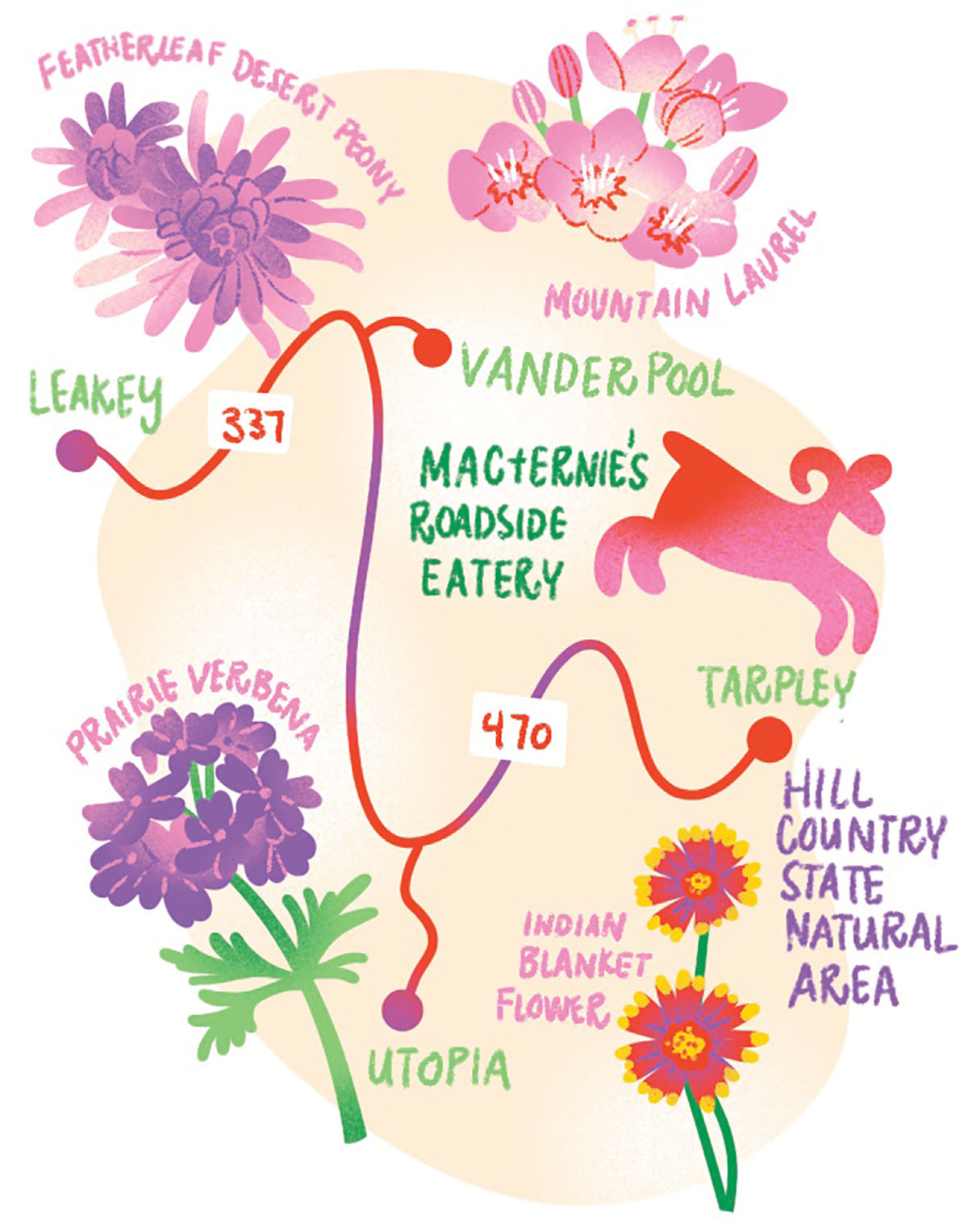
Western Hill Country
Leakey, Bandera, Utopia area
This western edge of the Hill Country features higher elevations, rugged terrain, and rare combinations of flora.
Scenic Ranch Road 337 between Leakey and Vanderpool passes craggy hillsides sporting Texas mountain laurel, mealy blue sage, and Lindheimer rock daisy. Larkspur and featherleaf desert peony also bloom in the area. Along the Medina River, this road passes perfume balls, agarita, and winecup, as well as water-loving cardinal flowers and chatterbox orchids growing on the banks.
Hill Country State Natural Area offers Indian blanket, daisies, and prairie spiderwort. Along Ranch Road 470 west of Bandera and the winding roads around Utopia, keep a lookout for prairie verbena, golden corydalis, and Texas skeleton plant.
The iconic Mac and Ernie’s Roadside Eatery in Tarpley has new ownership but a similar selection of elevated Texas standards such as ancho chile honey-basted quail and the locally sourced goat burger that was featured on Diners, Drive-Ins and Dives. Stop by Bandera Brewery and enjoy a craft IPA or kölsch in the pet-friendly outdoor beer garden.
Mac and Ernie’s: 830-562-3727; macandernies.com. Bandera Brewery: 830-522-4226; banderabrewery.com
East Texas
Nacogdoches area
East Texas might be better known for its towering pines and hardwood forests, but it also contains diverse ecosystems with generous and unusual assemblages of wildflowers.
Stephen F. Austin State University’s Pineywoods Native Plant Center houses rare native plants such as Neches River rosemallow and Texas trailing phlox, while cultivated wildflowers bloom in its Lady Bird Johnson Wildflower Demonstration Garden.
Drive State Highway 21 between Alto and Nacogdoches for showy dogwoods, redbuds, and Carolina yellow jessamine. Or explore US 59 between Atlanta and Linden for spiderwort, phlox, and milkweed.
If you’ve built up an appetite, tackle a double patty sour cream and cheddar burger at Butcher Boy’s Smokehouse, an area favorite for almost 50 years. Or maybe sample the variety of hearty pizzas baked on-site at Fredonia Brewery to complement pours of its house-forged porters and pilsners. Nearby Front Porch Distillery serves its artisan rum, whiskey, and flavored vodka beneath shady oaks.
Butcher Boy’s Smokehouse and Deli: 936-560-1137; butcherboysnac.com. Fredonia Brewery: 936-305-5125; fredoniabrewery.com. Front Porch Distillery: 936-564-3999; frontporchdistillery.com
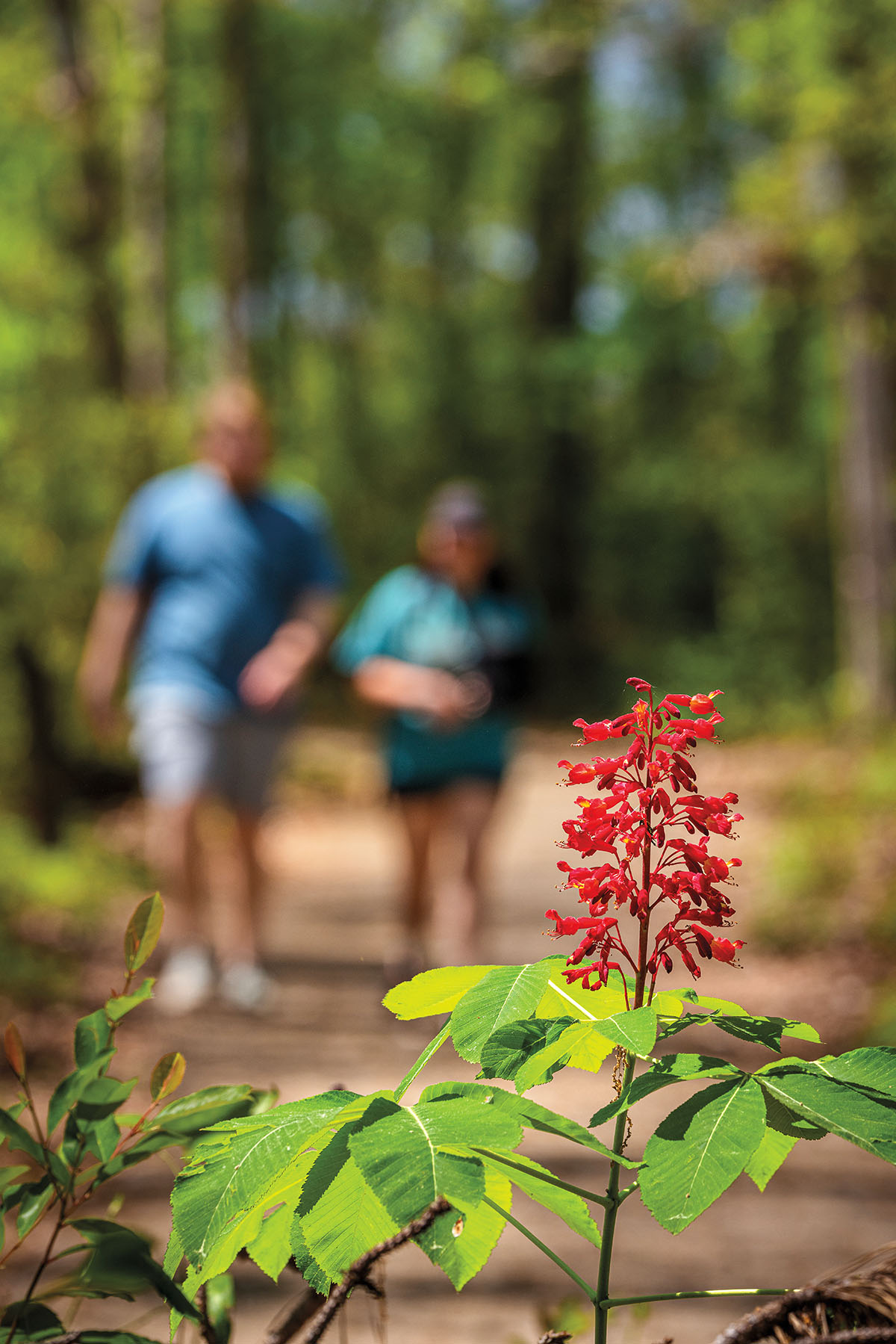
A red buckeye tree at the Stephen F. Austin State University Pineywoods Native Plant Center. Photo by Sean Fitzgerald
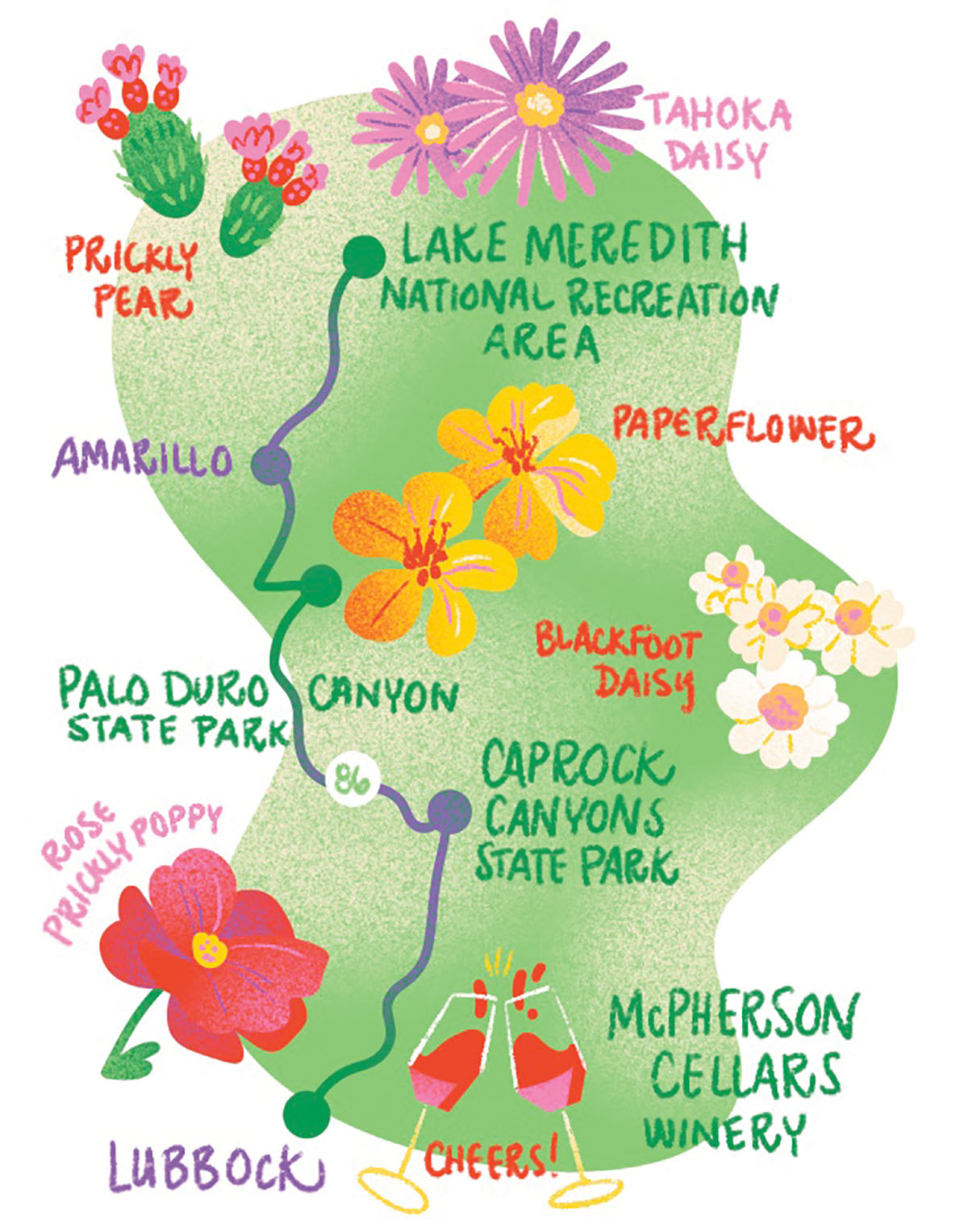
Panhandle
Lake Meredith, Palo Duro Canyon, Caprock Canyons area
The tall, sloping mesa of the Texas Panhandle Plains reaches elevations of 4,500 feet, with shortgrass prairie that invites diverse vegetation on its mix of mineral-rich, sandy loam lands and caliche lakes.
For instance, paperflower, blackfoot daisy, sand sage, and prickly pear can be found on more than 50 miles of hiking and biking trails in Palo Duro Canyon State Park. Book a cabin on the canyon rim to enjoy stunning views, or kick back at “glampsites” that boast fully furnished cabins with air-conditioning, outdoor gas grills, and more.
Lemon horsemint and white and rose prickly poppy grow on a 700-acre prairie near Caprock Canyons State Park headquarters, where the shaggy Texas State Bison Herd roams.
The Canadian River cuts a series of breaks through Lake Meredith National Recreation Area, creating microclimates for Tahoka, chocolate, and Engelmann daisies. The park’s Plum Creek area sports the bright yellow blooms of prairie zinnias and varieties of greenthread.
The arid, high elevation of the area invites cooler temperatures at night—ideal for growing balanced wine grapes. There’s no better example of this than the crisp Provençal-style rosé at McPherson Cellars. Run by a family of pioneering winemakers in the Texas High Plains region, the winery occupies a 1930s-era Coca-Cola bottling plant in downtown Lubbock.
McPherson Cellars: 806-687-9463; mcphersoncellars.com
Upper Coast
Brazos Bend, Beaumont, Brazoria, Sandyland area
The Upper Gulf Coast transitions from flat tallgrass prairie to rolling Piney Woods, with wildflowers beautifying every terrain.
Brazoria National Wildlife Refuge’s self-driving tour passes coreopsis, prairie nymph, and rain lilies, and the Discovery Center has a walking path to view delicate blanket flowers up close.
Brazos Bend State Park’s spring wildflowers include yellow star-grass and showy bluestar. As the sun dips below the horizon, stargazing is a must. The park provides Saturday programs at the George Observatory to take advantage of the nighttime display.
The Nature Conservancy’s Roy E. Larsen Sandyland Sanctuary contains more than 340 wildflower species, including Texas trailing phlox and wild azalea. Explore 6 miles of trails and bring a fishing pole to reel in a catch at Village Creek.
The vast Big Thicket National Preserve encompasses nine different ecosystems that house carnivorous pitcher plants. And speaking of carnivorous, the famous all-beef links and smoked shoulder clod at Patillo’s Barbeque in Beaumont are enough to sate any meat lover.
Patillo’s Barbeque: 409-833-3156; patillosbbqtx.com
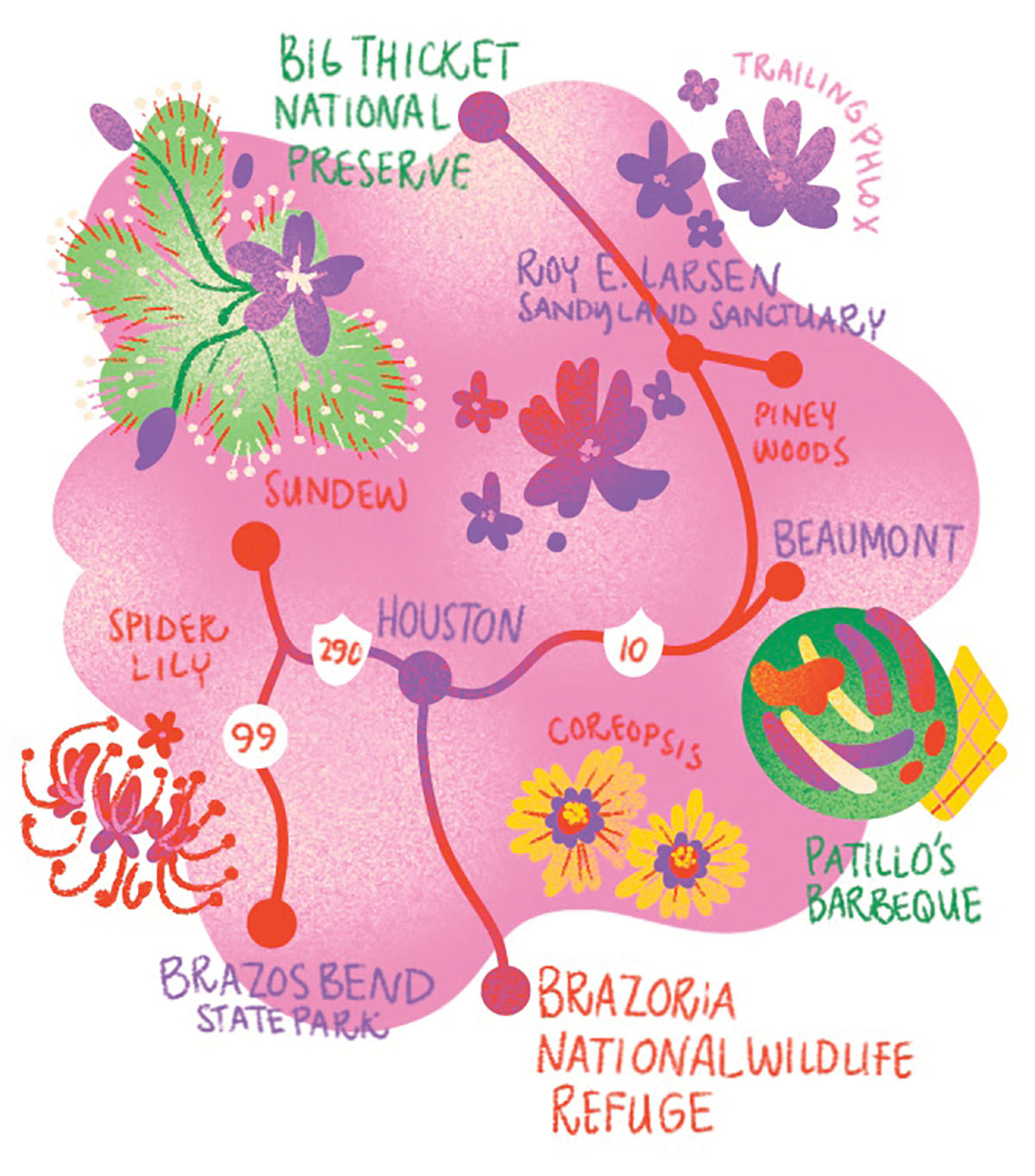
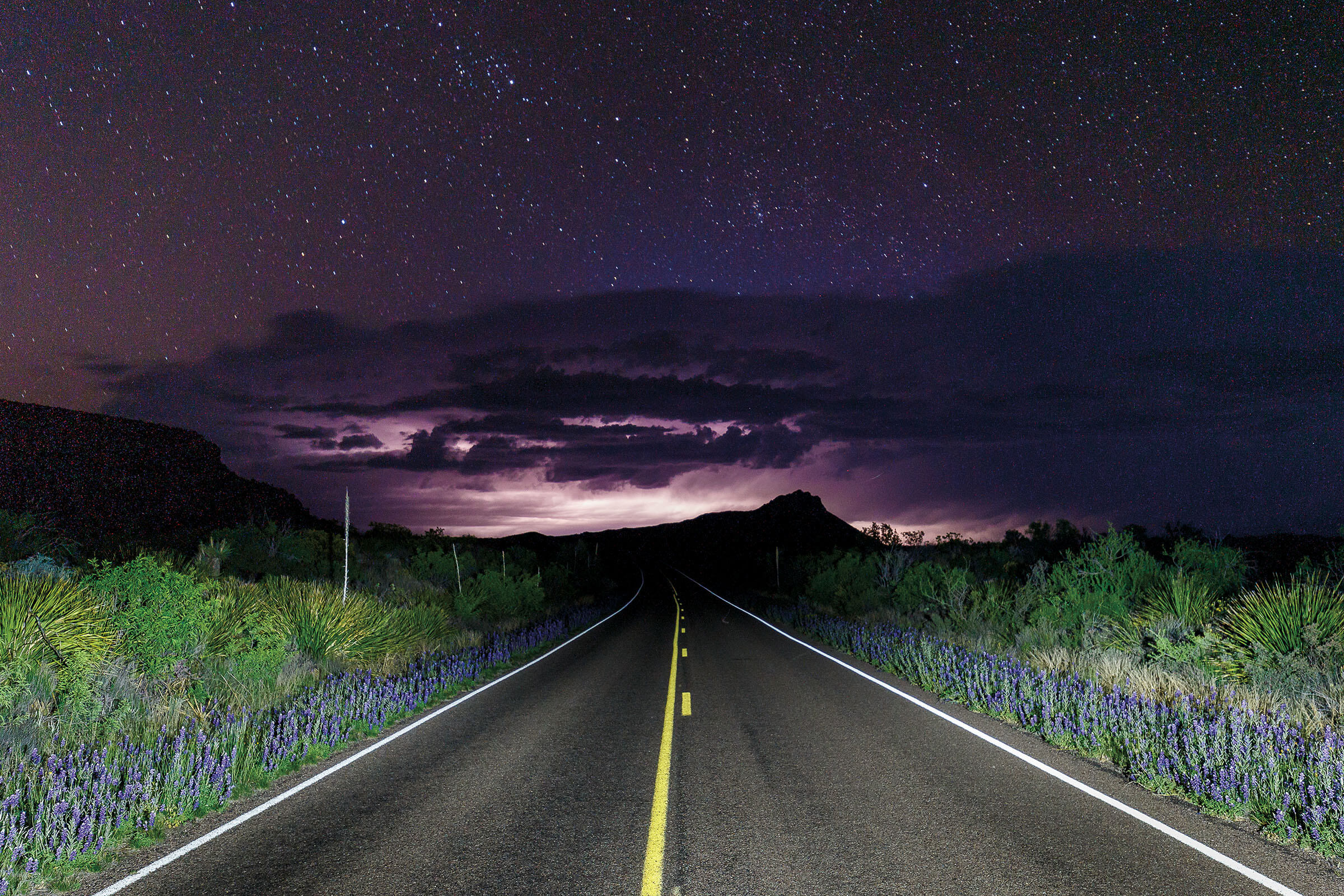
An electrical storm lights up roadside bluebonnets at Big Bend National Park. Photo by Sean Fitzgerald
Far West Texas
Big Bend National Park, Fort Davis, Alpine areas
Big Bend National Park is home to its own bluebonnet variety, an earlier and taller version of its cross-state cousins. The flowers, along with agarito and Texas rainbow cactus, line the park road west from Panther Junction.
Wind along Farm-to-Market Road 170, also known as Scenic River Road, west from Terlingua to see Big Bend bluebonnets, sand bells, and yellow desert marigolds. Ideal viewing spots include the teepee picnic area and Big Bend Ranch State Park’s Hoodoos Trailhead and Contrabando Multi-Use Trail.
On a 75-mile scenic loop from Fort Davis, scarlet bouvardia, silverleaf nightshade, and Apache plume blossom in Davis Mountains State Park. Also on this loop is The Nature Conservancy’s Davis Mountains Preserve, where you can spot rarities like the Livermore sandwort, many-flowered unicorn plant, and fringed paintbrush. Blooms along State Highway 118 from Fort Davis to Alpine include bladderpod, purple sand verbena, and desert marigold.
Terlingua’s historic Starlight Theatre puts prickly pear to good use in its Prickly Pear’ita, a riff on a classic margarita that utilizes syrup from the cactus fruit. Find an aesthetic nod to the historic mining town in the stacked-rock rooms of La Posada Milagro Guesthouse, a boutique hotel perched on a hillside with views of the mountains and the Milky Way from multiple terraces.
Starlight Theatre: 432-371-3400; thestarlighttheatre.com. La Posada Milagro Guesthouse: 424-645-8017; laposadamilagro.com
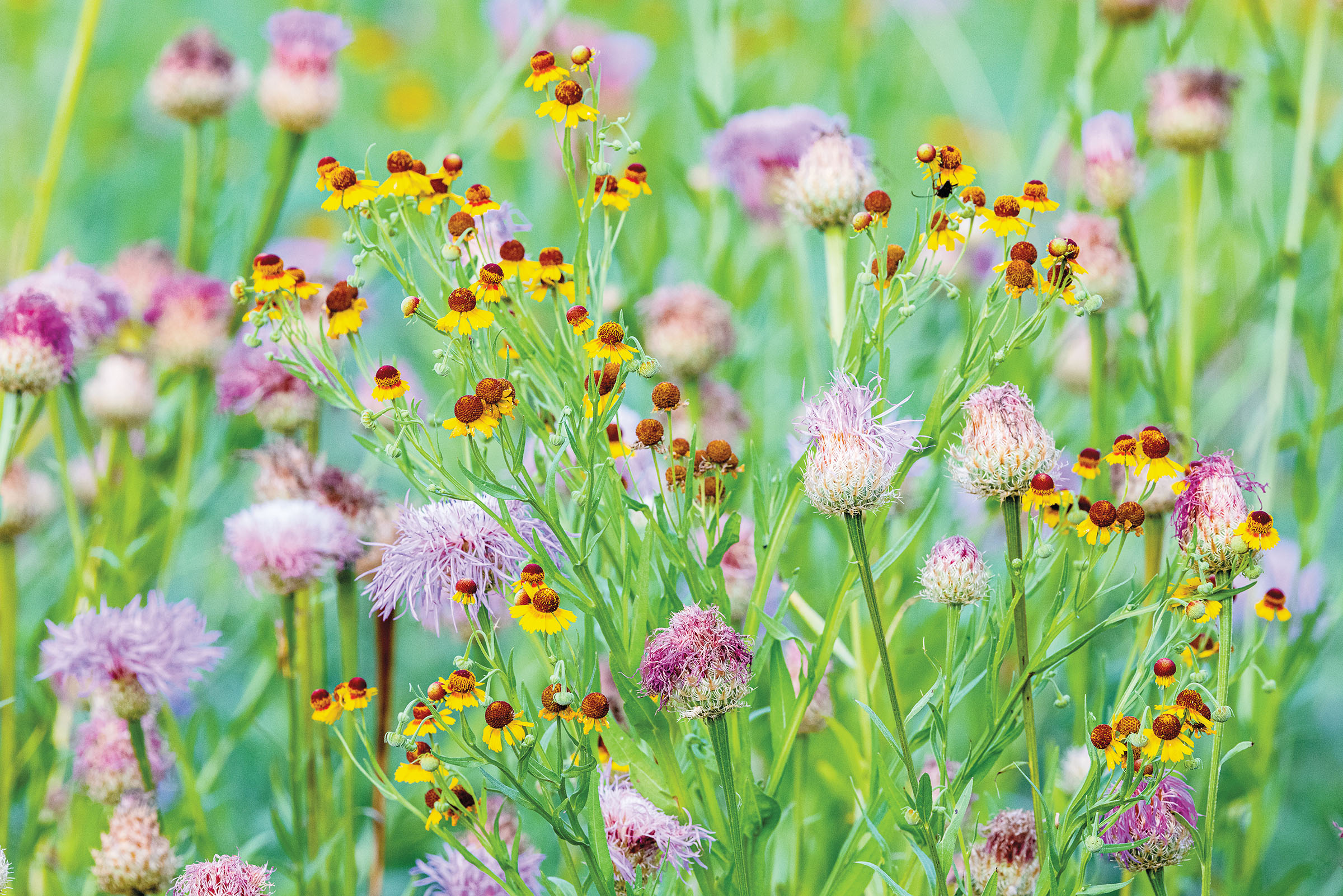
Pretty sneezeweed and American basketflower outside Benbrook Lake. Photo by Sean Fitzgerald
North-Central Texas
Stephenville, Hico, Comanche area
The North-Central Texas mix of savanna, woodlands, and prairie is known collectively as the Western Cross Timbers. US 377 from Comanche through Stephenville to Granbury rolls past pastures abounding in bluebonnets and Indian paintbrush, among other wildflowers.
Dinosaur Valley State Park boasts antelope horns and the delicate Texas skeleton plant—a sight that rivals the world-class dinosaur tracks fossilized in the beds of the nearby Paluxy River. Drive State Highway 16 between San Saba and Comanche for reliably stunning displays, and west from there on US 377 to see bluebonnets, winecup, and Indian paintbrush.
Destination-worthy wood-fired pizzas and espresso drinks await in Hico at the Buzzed Brumby, which serves unique offerings like a bourbon barrel-aged cold brew out of a converted horse trailer. Rest up for more bloom-chasing at The Midland Hotel, which dates to 1891 and includes The Chop House and 1896 Saloon.
Buzzed Brumby: 254-784-0897; buzzedbrumby.com. The Midland Hotel: 254-796-4426; historicmidlandhotel.com

Ground Rules
It’s springtime and, yes, the medians and meadows are alight with color. But before you pull over to admire the foliage, Andrea DeLong-Amaya, Lady Bird Johnson Wildflower Center’s director of horticulture, recommends some simple etiquette rules to follow.
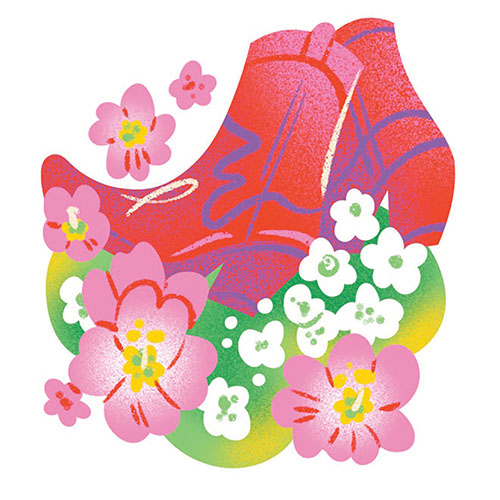
Don’t tread on the flowers. This may seem like a no-brainer, but DeLong-Amaya emphasizes the importance of keeping kids—and adults—from stomping out precious pollinators.
Do take the time to appreciate late October and November bloomers, such as goldenrod, with its tall branches full of bright yellow flowers. Also keep an eye out for stubborn white prickly poppies that survived the summer heat. If you’re not familiar, DeLong-Amaya says they’re recognizable by their white petals framing a yolk yellow center, which makes them “look like fried eggs.”
Don’t pull over on a busy highway, especially if you have kids in the car. Sure, acres of bluebonnets are stunning, but they’ll still be there if you take the time to find a safe place like a nearby parking lot or side road to park.
Do spread native seeds in your own yard to help pollinators. You don’t have to be a seasoned green thumb to plant seeds like basketflowers and milkweeds, which are less showy but still crucial for bees and butterflies.
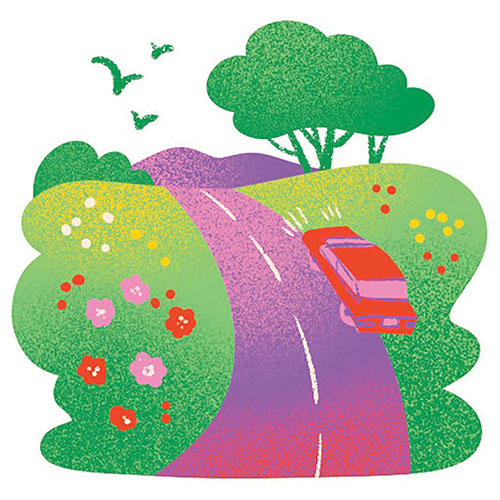
Do wear ankle-high hiking boots if you’re walking through tall grasses, just in case a rattler or coral snake is napping underfoot.
 Don’t trespass on private property to get the perfect picture. The state has laws against this, y’all.
Don’t trespass on private property to get the perfect picture. The state has laws against this, y’all.
Don’t pick bluebonnets. It might not be illegal, but removing large quantities of wildflowers and uprooting established plants can inhibit next year’s crop.
Picture Perfect
It takes a dedicated professional to have a year-round obsession for capturing that ideal shot of a bumblebee nestled atop the petals of a lantana. But award-winning photographer Theresa DiMenno has plenty of tips for amateur wildflower enthusiasts equipped with nothing more elaborate than a camera phone.
Texas Highways: What are your top tips when it comes to photographing wildflowers?
Theresa DiMenno: I know it sounds simplistic, but don’t trample them. Tread lightly because it affects the next season, since it can destroy the germination of the seeds. Plus, you don’t want to ruin it for the next person. Also, don’t get the barbed wire fence in your photo unless you want to incorporate that. It is part of the Texas landscape, but I would suggest shooting through or over it. Finally, wear snake boots.
TH: Do you have any advice as far as angles are concerned?
TD: I get down low a lot. I like to be intimate with the flowers and the insects, depending on what the scene is. I don’t really follow specific rules, but it’s about assessing the situation. Sometimes I get on a ladder or the roof of my car. But for close-ups, I would get down low and get a good angle on the entirety of the flower.
TH: Is there an ideal time of day?
TD: I shoot mostly at sunrise and sunset, since that light can be misty and moody. Don’t hesitate to shoot directly into the sun, especially during the golden hour. Backlit images are stunning and create a warm, intimate feeling.
TH: Any tips for cloudy days?
TD: Cloud cover is good, especially if you’re shooting in the middle of the afternoon. On a partly cloudy day, it’s fascinating to compare how varying light informs the flower. The tone, color, and details change. Take the same shot in both cloudy and full sun and just notice the vast difference in the two images.
TH: You’ve captured some gorgeous bluebonnet images. What other Texas wildflowers do you like to shoot?
TD: I like forked bluecurls and horsemint, also known as spotted beebalm. It’s a very unique and beautiful flower. The purple coneflower (aka echinacea) is another favorite, as well as firewheels and red drummond phlox.
TH: Are there resources you recommend that might help people find the best locations to take photos?
TD: There’s Texas Wildflower Report on Facebook. Otherwise, get out there, relax, and listen to music. Enjoy the process.

I like to be intimate with the flowers and the insects, depending on what the scene is. I don’t really follow specific rules, but it’s about assessing the situation.
Photo Synthesis
Like eating a fried Oreo at the State Fair of Texas, taking a picture among a field of wildflowers is a rite of passage in the Lone Star State. Michael Eason, associate director of conservation and collections at the San Antonio Botanical Garden, offers a regional guide to ensure your photo-ops are tiptop.
Central Texas
Wildseed Farms
A working wildflower farm and winery in the Hill Country, this Fredericksburg locale promises more than 200 acres of evening primrose, bluebonnets, lemon mint, and firewheels to enjoy. 100 Legacy Drive, Fredericksburg. wildseedfarms.com
The San Antonio Botanical Garden
Regarded as a 38-acre “living museum,” San Antonio’s Botanical Garden has grounds full of succulents, roses, and wildflowers. Plus, the 11-acre Texas Native Trail lets you explore plants from three distinct regions of the state. 555 Funston Place, San Antonio. sabot.org
West Texas
Chihuahuan Desert Nature Center
For 50 years, this 507-acre sanctuary has worked to preserve native plants and educate the public about their importance. A botanical garden with trails and paths winds through fields of nearly 165 species of Trans-Pecos Region native plants like chocolate daisy and yellow columbine. 43869 SH 118, Fort Davis. cdri.org
River Road in Big Bend National Park
Eason suggests checking out the roadside blooms along River Road and other spots around the park if you want to see lupine, desert marigold, and desert lantana. nps.gov/places/river-road-east
South Texas
Sand Sheets
This area covers over 2 million acres of the southern tip of the state, and if you drive through in spring and summer, you’re likely to stumble upon blue curls, showy nerveray, and Amelia’s sand verbena.
East Texas
Watson Rare Native Plant Preserve
Eason sites Warren—located about 45 miles outside of Beaumont—as one of his favorite wildflower spots in East Texas. Depending on the time of year, rare orchids, azaleas, pitcher plants, and gayfeather blanket the site. 527 County Road 4777, Warren. watsonpreserve.ning.com
Roadside Blooms Outside Nacogdoches
The backroads between Nacogdoches and Lufkin provide plenty of opportunities to pull over (safely) in the spring and check out vast fields of violets and yellow wild indigo scattered among bluebonnets and Mexican hats.
Panhandle
Palo Duro Canyon State Park
The second largest canyon in the country boasts bright blooms during the spring and early summer. Hike the trails and snap shots of the vegetation blooming out of the red clay soil. You’ll see yellow sundrops, purple winecups, and orange globe mallow. 11450 Park Road 5, Canyon. palodurocanyon.com
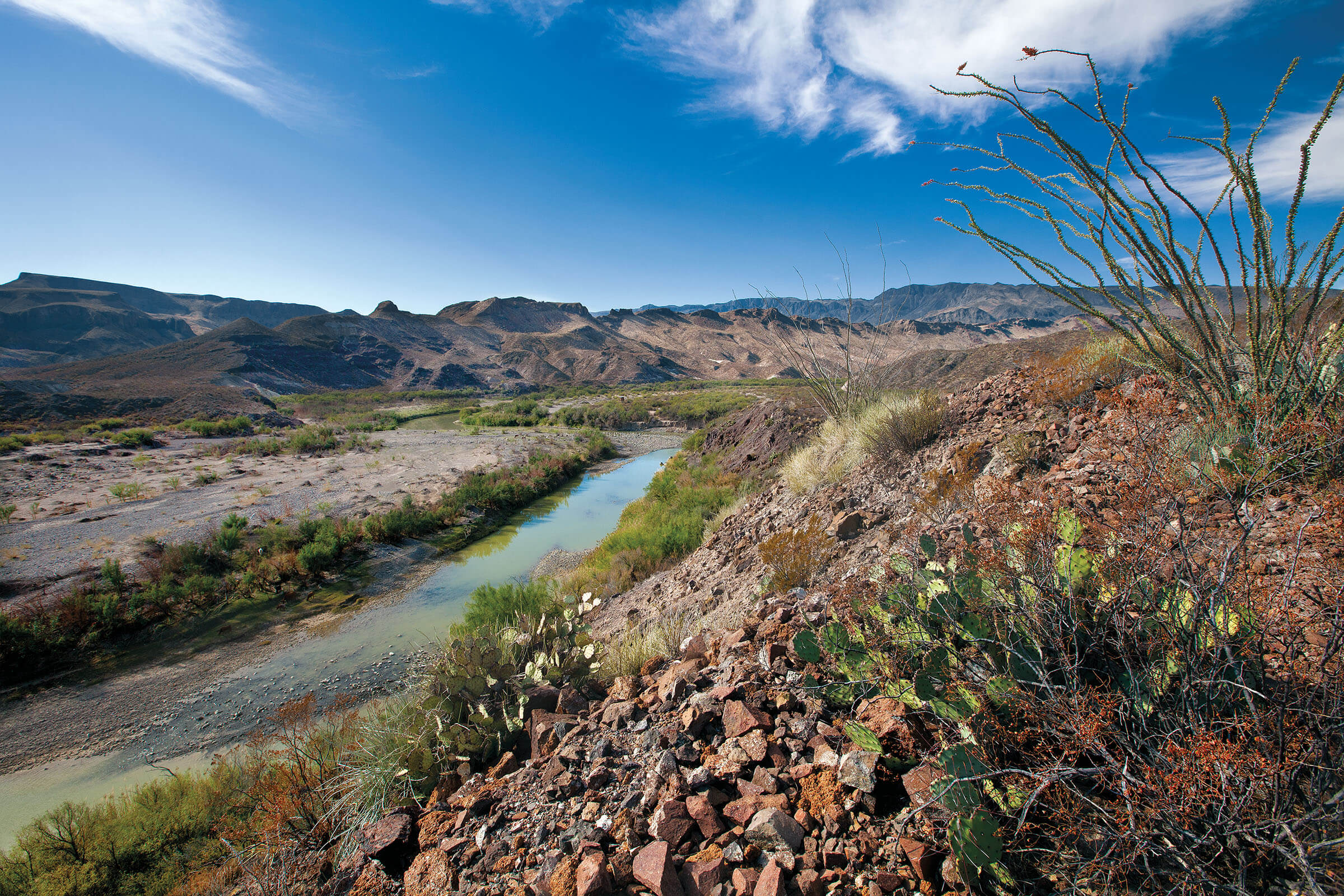
Ocotillo grows at Big Bend Ranch State Park. Photo by J. Griffis Smith
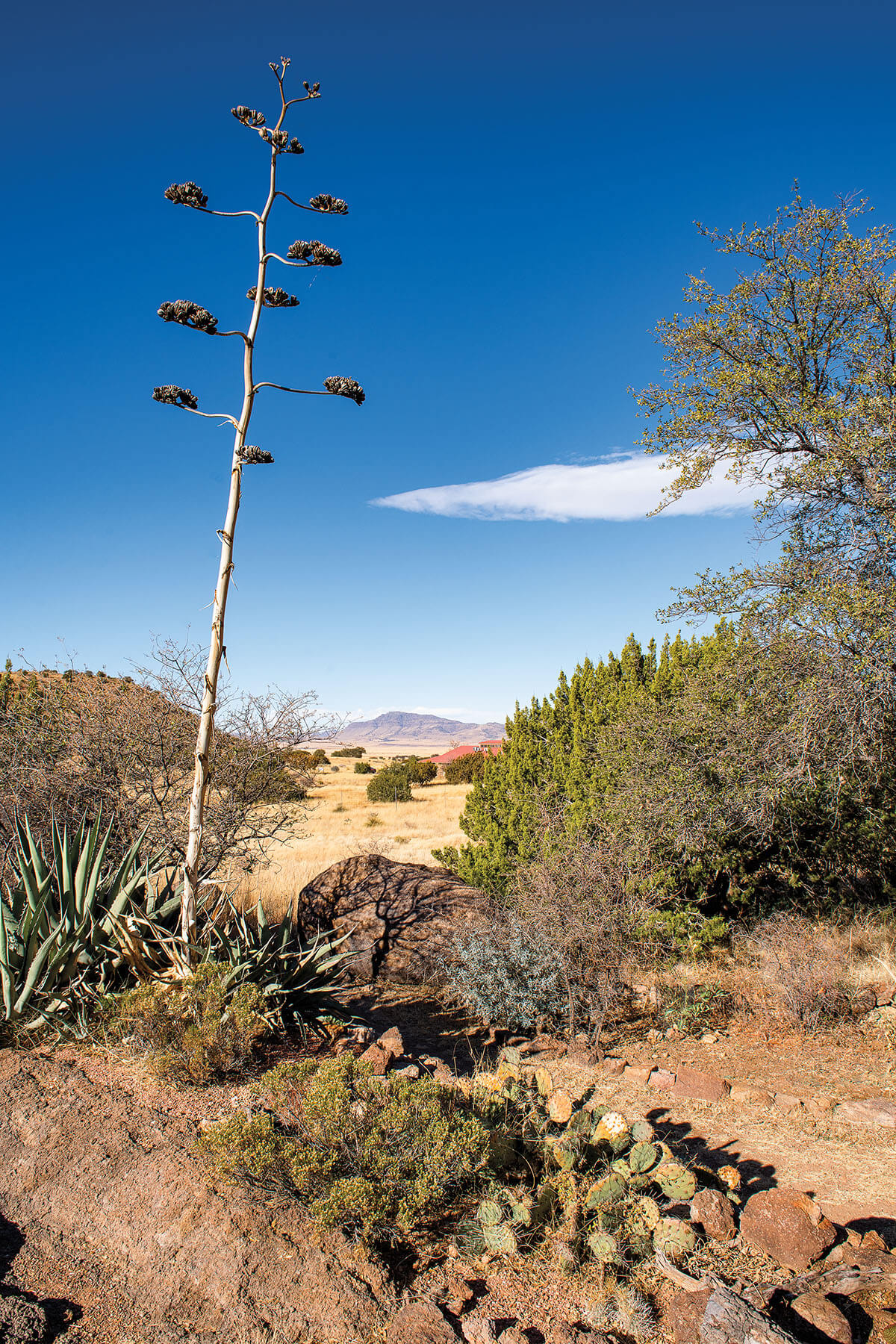
The Chihuahuan Desert Nature Center. Photo by Theresa DiMenno
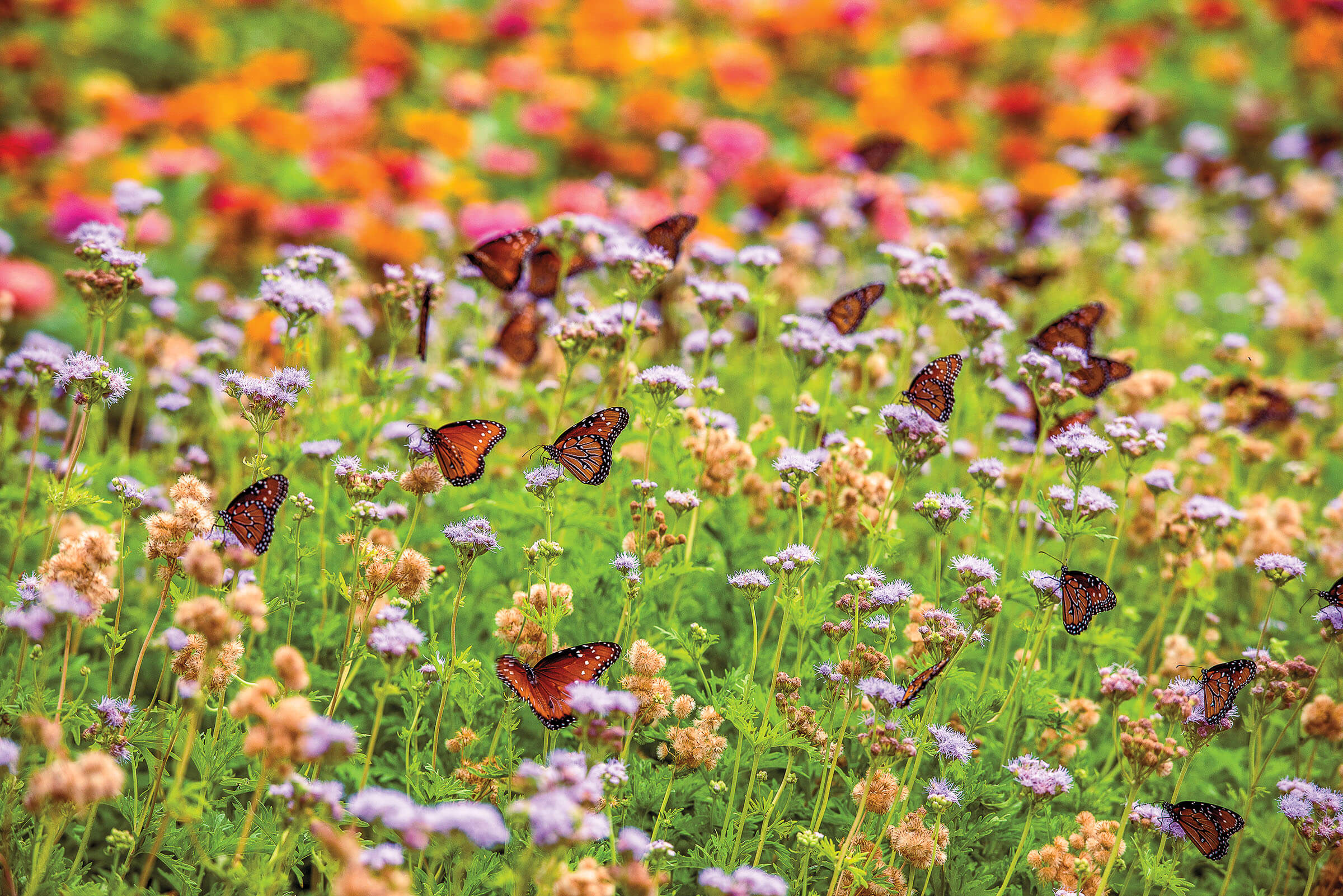
A butterfly garden at Wildseed Farms. Photo by Michael Amador









